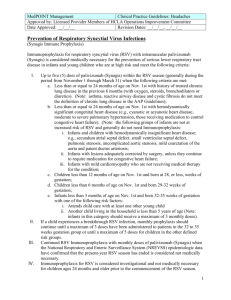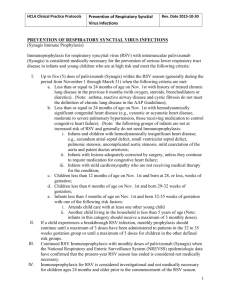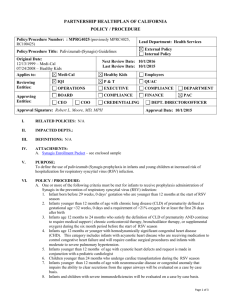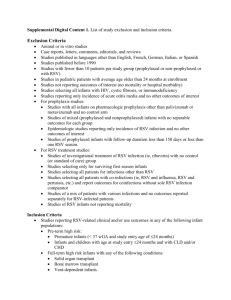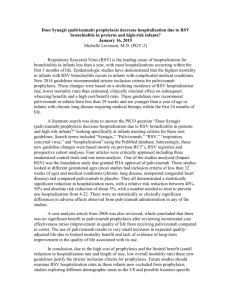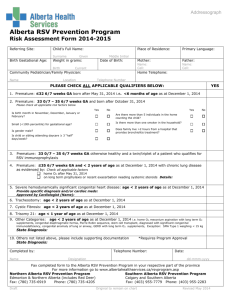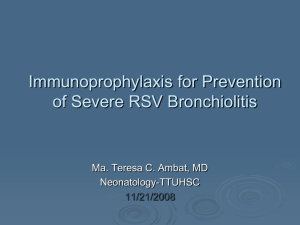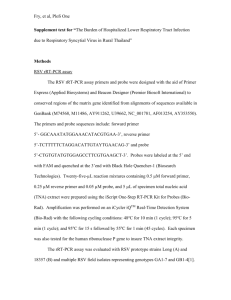Synagis
advertisement
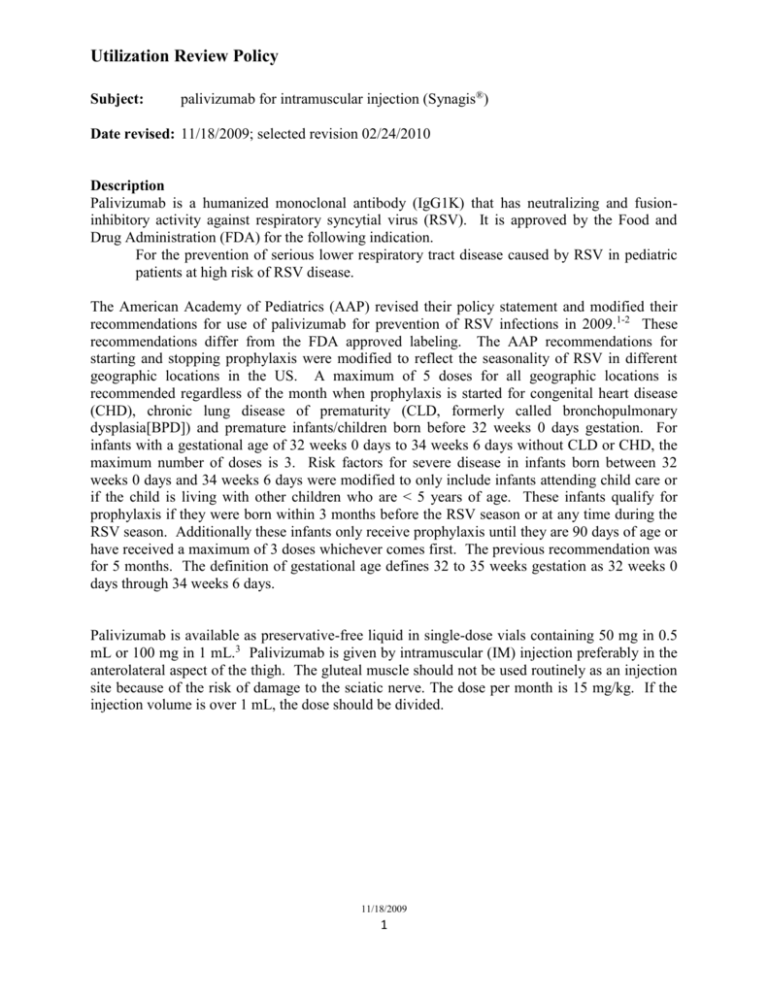
Utilization Review Policy Subject: palivizumab for intramuscular injection (Synagis®) Date revised: 11/18/2009; selected revision 02/24/2010 Description Palivizumab is a humanized monoclonal antibody (IgG1K) that has neutralizing and fusioninhibitory activity against respiratory syncytial virus (RSV). It is approved by the Food and Drug Administration (FDA) for the following indication. For the prevention of serious lower respiratory tract disease caused by RSV in pediatric patients at high risk of RSV disease. The American Academy of Pediatrics (AAP) revised their policy statement and modified their recommendations for use of palivizumab for prevention of RSV infections in 2009.1-2 These recommendations differ from the FDA approved labeling. The AAP recommendations for starting and stopping prophylaxis were modified to reflect the seasonality of RSV in different geographic locations in the US. A maximum of 5 doses for all geographic locations is recommended regardless of the month when prophylaxis is started for congenital heart disease (CHD), chronic lung disease of prematurity (CLD, formerly called bronchopulmonary dysplasia[BPD]) and premature infants/children born before 32 weeks 0 days gestation. For infants with a gestational age of 32 weeks 0 days to 34 weeks 6 days without CLD or CHD, the maximum number of doses is 3. Risk factors for severe disease in infants born between 32 weeks 0 days and 34 weeks 6 days were modified to only include infants attending child care or if the child is living with other children who are < 5 years of age. These infants qualify for prophylaxis if they were born within 3 months before the RSV season or at any time during the RSV season. Additionally these infants only receive prophylaxis until they are 90 days of age or have received a maximum of 3 doses whichever comes first. The previous recommendation was for 5 months. The definition of gestational age defines 32 to 35 weeks gestation as 32 weeks 0 days through 34 weeks 6 days. Palivizumab is available as preservative-free liquid in single-dose vials containing 50 mg in 0.5 mL or 100 mg in 1 mL.3 Palivizumab is given by intramuscular (IM) injection preferably in the anterolateral aspect of the thigh. The gluteal muscle should not be used routinely as an injection site because of the risk of damage to the sciatic nerve. The dose per month is 15 mg/kg. If the injection volume is over 1 mL, the dose should be divided. 11/18/2009 1 Palivizumab injection (Synagis) Indications, Medically Necessary 1. Prevention of RSV infection in a child with chronic lung disease (CLD)/bronchopulmonary dysplasia (BPD): Indicated for the prevention of RSV in children with CLD who meet all of the following criteria. Child is ≤ 24 months of age,1 and The child has required medical therapy (e.g., supplemental oxygen, bronchodilator, diuretic, or chronic corticosteroid therapy) for their CLD/BPD within 6 months before the start of the anticipated RSV season.1 Dosing in children with CLD: The dose of palivizumab is 15 mg/kg once monthly given IM during the RSV season.1 Initial approval/extended approval: approve a maximum of 5 months (5 doses) during the RSV season (lasting November through March in most areas).1-2,4 [Example: If the child meets criteria in November, approve for 5 months (5 doses); if patient meets criteria in December, approve for 4 months (4 doses) etc.] [Note: RSV season in some areas of the US commences earlier than November, such as in Florida, where the onset may be as early as July. The RSV season is of the same duration (5 months) for Florida therefore, if a patient is eligible in July, approve 5 monthly doses, if a patient is eligible in August, approve 4 monthly doses etc]. Duration of therapy in children with CLD: as above under initial approval/extended approval. Children with the most severe CLD who continue to require medical therapy may benefit from prophylaxis during a second RSV season.1-2 These patients must still meet the criteria above if they are treated during a second RSV season. Labs/Diagnostics required: Chest x-ray confirms diagnosis of CLD. Waste management: The dose is 15 mg/kg with the dose being adjusted each month as the child’s weight changes. Exclusions: Infants/children with CLD. See more below. Children with asthma or reactive airway disease. 11/18/2009 2 Palivizumab injection (Synagis) 2. Prevention of RSV infection in a child with congenital heart disease (CHD): Indicated for the prevention of RSV in children with CHD who meet all of the following criteria. Child is ≤ 24 months of age,1 and A cardiologist or intensivist has evaluated the child and considers the CHD (acyanotic or cyanotic) hemodynamically significant. Dosing in children with CHD: The dose of palivizumab is 15 mg/kg once monthly given IM during the RSV season.3 Initial approval/extended approval: approve a maximum of 5 months (5 doses) during the RSV season (lasting November through March in most areas).1-2,4 Exceptions can be made for children who undergo surgical procedures that use cardiopulmonary bypass and who continue to need prophylactic palivizumab.1-2 They should receive a postoperative dose of pavilizumab as soon as they are medically stable, even if this is sooner than when the next monthly dose is due. This could be an additional dose to allow coverage during the RSV season. [Example: If the child meets criteria in November, approve for 5 months (5 doses); if patient meets criteria in December, approve for 4 months (4 doses) etc.] [Note: RSV season in some areas of the US commences earlier than November, such as in Florida, where the onset may be as early as July. The RSV season is of the same duration (5 months) for Florida therefore, if a patient is eligible in July, approve 5 monthly doses, if a patient is eligible in August, approve 4 monthly doses etc]. Duration of therapy in children with CHD: as above under initial approval/extended approval. Labs/Diagnostics required: none. Waste management: The dose is 15 mg/kg with the dose being adjusted each month as the child’s weight changes. Exclusions: Infants/children with CHD. See more below. Infants and children with hemodynamically insignificant heart disease (e.g., secundum atrial septal defect, small ventricular septal defect, pulmonic stenosis, uncomplicated aortic stenosis, mild coarctation of the aorta, and patent ductus arterious).1 Infants with lesions adequately corrected by surgery, unless they continue to require medication for congestive heart failure.1 Infants with mild cardiomyopathy who are not receiving medical therapy for the condition.1 3. Prevention of RSV infection in children born prematurely: Indicated for the prevention of RSV in children born prematurely who meet all of the following criteria. 11/18/2009 3 Palivizumab injection (Synagis) If the child is ≤ 12 months of age at the start of the RSV season and was born at 28 weeks, 6 days gestation or earlier1 OR If the child is < 6 months of age at the start of the RSV season and was born at between 29 weeks, 0 days gestation and < 32 weeks (≤ 31 weeks, 6 days) gestation1 OR If the infant is < 3 months of age at the start of the RSV season or was born during the RSV season AND was born between 32 weeks, 0 days gestation and < 35 days (≤ 34 weeks, 6 days) gestation AND has one of the following risk factors:1 Is attending child care, defined as a home or facility where care is provided for any number of infants or young toddlers in the child care facility OR Child lives permanently in a household with a child such as a sibling or another child who is < 5 years of age. Dosing in children born prematurely: The dose of palivizumab is 15 mg/kg once monthly given IM during the RSV season.3 Initial approval/extended approval: Child ≤ 12 months of age and was born at 28 weeks 6 days gestation or earlier: approve a maximum of 5 months (5 doses).1 See Table 1 for number of doses. These children continue throughout the RSV season and do not stop if they reach 12 months of age.1 Table 1. Chronological age: ≤ 12 months at Start of Season and Gestational age ≤ 28 weeks 6 days.1 Birth Month Maximum number of doses (months) for areas beginning prophylaxis on November 1 November 1 to March 31 of previous RSV 5a season April, May, June, July, August, September, 5 October, or November December 4 January 3 February 2 March 1 If infant is discharged from the hospital during RSV season, fewer doses may be required. a Some of these infants may have received 1 or more doses of palivizumab in the previous RSV season if discharged from the hospital during that season; if so, they still qualify for up to 5 doses during their second RSV season. Child < 6 months of age and was born at between 29 weeks 0 days gestation and < 32 weeks (≤ 31 weeks 6 days) gestation: approve a maximum of 5 months (5 doses).1 See Table 2 for number of doses. These children continue throughout the RSV season and do not stop if they reach 6 months of age.1 Table 2. Chronological age: < 6 months at Start of RSV Season and Gestational age: 29 weeks to < 32 weeks (≤31 weeks 6 days).1 11/18/2009 4 Palivizumab injection (Synagis) Birth Month November 1 to March 31 of previous RSV season Maximum number of doses (months) for areas beginning prophylaxis on November 1 0b April 0b May, June, July, August, September, October, or 5 November December 4 January 3 February 2 March 1 If infant is discharged from the hospital during RSV season, fewer doses may be required. b Zero doses because infant will be older than 6 months of age at start of RSV season. Child < 3 months of age at the start of the RSV season or who was born during the RSV season and who were born between 32 weeks 0 days gestation and < 35 days (≤ 34 weeks 6 days) gestation: a maximum of 3 months (3 doses) during the RSV season (lasting November through March in most areas).1 See Table 3 for number of doses. These infants only receive prophylaxis until they reach 3 months of age. Table 3. Chronological age: < 3 months of age and Gestational age: 32 weeks to < 35 weeks gestation (≤ 34 weeks 6 days), AND has one of the two risk factors.1,c Birth Month Maximum number of doses (months) for areas beginning prophylaxis on November 1 November 1 to March 31 of previous RSV season 0d April, May, June, or July 0d August 1e September 2e October, November, December or January 3e February 2e March 1e If infant is discharged from the hospital during RSV season, fewer doses may be required. c Risk factors: infant attends child care or has sibling younger than 5 years of age. d Zero doses because infant will be older than 90 days of age at start of RSV season. e On the basis of the age of patients at the time of discharge from the hospital, fewer doses may be required, because these infants will receive 1 dose every 30 days until the infant is 90 days of age. Duration of therapy in children born prematurely: approval/extended approval. as above under initial Labs/Diagnostics required: none. Waste management: The dose is 15 mg/kg with the dose being adjusted each month as the child’s weight changes. Exclusions: See below. 11/18/2009 5 Palivizumab injection (Synagis) 4. Prevention of RSV infection in a child who has congenital abnormalities of the airways or a neuromuscular disease: Indicated for the prevention of RSV in children with congenital abnormalities of the airways or a neuromuscular disease who meet all of the following criteria. Child was born < 35 weeks (≤ 34 weeks, 6 days) gestation1 and Child is ≤ 12 months of age1 and According to the prescribing physician, the patient’s congenital abnormality compromises handling of respiratory secretions and the patient is predisposed to respiratory complications and. The patient does not have CLD or CHD.1 Dosing in child with congenital abnormalities of the airways or a neuromuscular disease: The dose of palivizumab is 15 mg/kg once monthly given IM during the RSV season.3 Initial approval/extended approval: approve a maximum of 5 months (5 doses) during the RSV season (lasting November through March in most areas).1 [Example: If the child meets criteria in November, approve for 5 months (5 doses); if patient meets criteria in December, approve for 4 months (4 doses) etc.] [Note: RSV season in some areas of the US commences earlier than November, such as in Florida, where the onset may be as early as July. The RSV season is of the same duration (5 months) for Florida therefore, if a patient is eligible in July, approve 5 monthly doses, if a patient is eligible in August, approve 4 monthly doses etc]. Duration of therapy in children with congenital abnormalities of the airways or a neuromuscular disease: as above under initial approval/extended approval. Labs/Diagnostics required: none. Waste management: The dose is 15 mg/kg with the dose being adjusted each month as the child’s weight changes. Exclusions: see below. 5. Prevention of RSV infection in an immunocompromised child. Indicated for the prevention of RSV infection in immunocompromised infants or children who meet all of the following criteria. [NOT FDA-APPROVED INDICATION] Prescribed by an immunologist or an infectious disease specialist or a pediatrician and 11/18/2009 6 Palivizumab injection (Synagis) Child has a severe immunodeficiency (e.g., severe combined immunodeficiency, advanced acquired immune deficiency disease (AIDS)) as determined by the prescribing physician that puts the child at significant risk of RSV infection and Child is ≤ 24 months of age. Dosing in severely immunocompromised children: The dose of palivizumab is 15 mg/kg once monthly given IM during the RSV season. Initial approval/extended approval: approve a maximum of 5 months (5 doses) during the RSV season (lasting November through March in most areas). [Example: If the child meets criteria in November, approve for 5 months (5 doses); if patient meets criteria in December, approve for 4 months (4 doses) etc.] [Note: RSV season in some areas of the US commences earlier than November, such as in Florida, where the onset may be as early as July. The RSV season is of the same duration (5 months) for Florida therefore, if a patient is eligible in July, approve 5 monthly doses, if a patient is eligible in August, approve 4 monthly doses etc]. Duration of therapy in severely immunocompromised children: as above under initial approval/extended approval. These children who continue to require medical therapy may benefit from prophylaxis during a second RSV season. These patients must still meet the criteria above if they are treated during a second RSV season. Labs/Diagnostics required: none. Waste management: The dose is 15 mg/kg with the dose being adjusted each month as the child’s weight changes. Exclusions: See below. 11/18/2009 7 Palivizumab injection (Synagis) Exclusions for all: Treatment of established RSV disease.1,3 However, if a child already on palivizumab experiences a breakthrough RSV infection, monthly prophylaxis should continue until the maximum number of doses allowed have been given. Previous severe reaction to palivizumab.3 Cystic fibrosis in children. According to AAP recommendations, a recommendation for routine prophylaxis in these patients cannot be made.1 There is insufficient data to determine the effectiveness of palivizumab in these patients.5-8 Patients with hematopoietic stem cell transplantation.9-10 REFERENCES 1. Committee on Infectious Diseases. Policy Statement--Modified Recommendations for Use of Palivizumab for Prevention of Respiratory Syncytial Virus Infections. Pediatrics. 2009 Sep 7. [Epub ahead of print] Accessed 10/26/2009 at: http://pediatrics.aappublications.org/cgi/reprint/peds.2009-2345v1 2. American Academy of Pediatrics. Respiratory Syncytial Virus. In: Pickering LK, Baker CJ, Long SS, McMillan JA, eds. Red Book:2009 Report of the Committee on Infectious Diseases. 28th ed. Elk Grove Village, IL: American Academy of Pediatrics. 2009(1):560. 3. Synagis injection [package insert]. Gaithersburg, MD: MedImmune LLC; March 2009. 4. Brief report: respiratory syncytial virus activity – United States, July 2007-December 2008. MMWR Morb Mortal Wkly Rep. 2008;57:1355-1358. Accessed 10/26/2009 at http://www.cdc.gov/mmwr/preview/mmwrhtml/mm5750a3.htm. 5. Malfroot A, Adam G, Ciofu O, et al. Immunization in the current management of cystic fibrosis patients. J Cyst Fibros. 2005;4:77-87. 6. Speer ME, Fernandes CJ, Boron M, Groothuis JR. Use of palivizumab for prevention of hospitalization as a result of respiratory syncytial virus in infants with cystic fibrosis. Pediatr Infect Dis J. 2008;27(6):559-561. #14 7. Giebels K, Marcotte JE, Podoba J, et al. Prophylaxis against respiratory syncytial virus in young children with cystic fibrosis. Pediatr Pulmonology. 2008;43:169-174. #15 8. Giusti R. North American Synagis Prophylaxis survey. Pediatr Pulmonol. 2009;44:96-98. 9. Boeckh M, Berrey MM, Bowden RA, et al. Phase 1 evaluation of the respiratory syncytial virus-specific monoclonal antibody palivizumab in recipients of hematopoietic stem cell transplants. J Infect Dis. 2001;184:350-354. 10. Dykewicz CA. Guidelines for preventing opportunistic infections among hematopoietic stem cell transplant recipients: focus on community respiratory virus infections. Biol Blood Marrow Transplant. 2001;7:19S-22S. 11. The Impact RSV Study Group. Palivizumab, a humanized respiratory syncytial virus monoclonal antibody, reduces hospitalization from respiratory syncytial virus infection in high risk infants. Pediatrics. 1998;102:531-537. 12. Feltes TF, Cabalka AK, Meissner HC, et al. Palivizumab prophylaxis reduces hospitalization due to respiratory syncytial virus in young children with hemodynamically significant congenital heart disease. J Pediatr. 2003;143:532-540. OTHER REFERENCES 1. 2. 3. 4. 5. Romero JR. Palivizumab prophylaxis of respiratory syncytial virus disease from 1998 to 2002: results from four years of palivizumab usage. Pediatr Infect Dis J. 2003;22(Suppl 2):S46-54 Heikkinen T, Valkonen H, Lehtonen L, et al. Hospital admission of high risk infants for respiratory syncytial virus infection: implications for palivizumab prophylaxis. Arch Dis Child Fetal Neonatal Ed. 2005;90:F64-68. Grimaldi M, Gouyon B, Michaut F, et al; for the Burgundy Perinatal Network. Severe respiratory synctial virus bronchiolitis: epidemiologic variations associated with the initiation of palivizumab in severely premature infants with bronchopulmonary dysplasia. Pediatr Infect Dis J. 2004;23:1081-1085. Meissner HC, Anderson LJ, Pickering LK. Annual variation in respiratory syncytial virus season and decisions regarding immunoprophylaxis with palivizumab. Pediatrics. 2004;114:1082-1084. Hall CB, Weinberg GA, Iwane MK, et al. The burden of respiratory syncytial virus infection in young children. N Engl J Med. 2009;360:588-598. 11/18/2009 8 Palivizumab injection (Synagis) ABBREVIATIONS AAP = American Academy of Pediatrics BPD = bronchopulmonary dysplasia, now called CLD CHD = congenital heart disease CLD = chronic lung disease of prematurity FDA = Food and Drug Administration IM = intramuscular mL = milliliter RSV = respiratory syncytial virus < less than ≤ less than or equal to OVERVIEW INDICATIONS AND USAGE: Palivizumab is indicated for the prevention of serious lower respiratory tract disease caused by respiratory syncytial virus (RSV) in pediatric patients at high risk of RSV disease.3 Safety and efficacy were established in infants with bronchopulmonary dysplasia (BPD), infants with a history of premature birth (≤ 35 weeks gestational age), and children with hemodynamically significant congenital heart disease (CHD). The first pivotal trial for palivizumab was conducted during the 1996 to 1997 RSV season11 and the second was during 4 consecutive RSV seasons, 1998 through 2002.12 Both studies used a reduction in hospitalization due to RSV infection as the primary endpoint. In the first study, monthly doses of palivizumab for 5 months was safe and effective for the prevention of serious RSV infection in premature children (≤ 35 weeks gestation) and in those with CLD or prematurity (formerly called BPD).11 In this study, hospitalizations for RSV were reduced when compared to placebo, i.e., in children with prematurity but not with CLD had a 78% reduction in RSV hospitalization (8.1% vs. 1.8%). Children with CLD had a 39% reduction (12.8% vs. 7.9%). Children on palivizumab had fewer total RSV hospital days, fewer RSV hospital days with increased oxygen, fewer RSV hospital days with a moderate/severe lower respiratory tract illness, and a lower incidence of intensive care unit admission. In the second study, children with hemodynamically significant CHD received 5 monthly doses of palivizumab or placebo.12 Children on palivizumab had a 45% relative reduction in RSV hospitalizations, a 56% reduction in total days of RSV hospitalization per 100 children, and a 73% reduction in total RSV hospital days with increased supplemental oxygen per 100 children. Children with CHD. The AAP 2009 RSV guidelines recommend prophylactic palivizumab in children ≤ 24 months of age with cyanotic or acyanotic heart disease.1-2 The children most likely to benefit are 1) infants receiving medication for congestive heart failure (CHF), 2) infants with moderate to severe pulmonary hypertension, and 3) infants with cyanotic heart disease. The following groups of infants are not at increased risk of RSV and generally should not receive prophylaxis with palivizumab: 1) infants and children with hemodynamically insignificant heart disease (e.g., secundum atrial septal defect, small ventricular septal defect, pulmonic stenosis, uncomplicated aortic stenosis, mild coarctation of the aorta, and patent ductus arteriosus; 11/18/2009 9 Palivizumab injection (Synagis) 2) infants with lesions adequately corrected by surgery, unless they continue to require medication for CHF; and 3) infants with mild cardiomyopathy who are not receiving medical therapy for the condition. Immunocompromised children. According to AAP recommendations, specific recommendations for immunocompromised children cannot be made, but infants and young children with severe immunodeficiency (e.g., severe combined immunodeficiency or advanced acquired immune deficiency disease (AIDS)) may benefit from prophylaxis.1 11/18/2009 10
